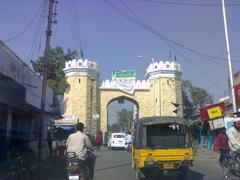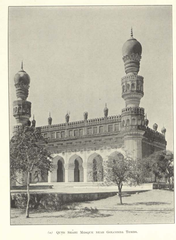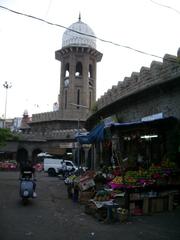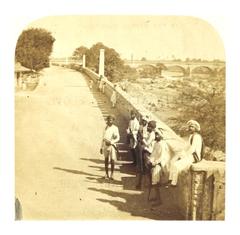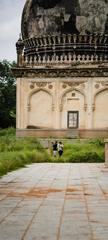
Osmania General Hospital: Visiting Hours, Ticket Information, and Historical Guide for Hyderabad
Date: 04/07/2025
Introduction
Osmania General Hospital (OGH) is a monumental institution in Hyderabad, standing at the confluence of medical legacy, architectural splendor, and urban history. Established in 1925 during the reign of the last Nizam, Mir Osman Ali Khan, OGH has not only served as a premier public healthcare facility but has also emerged as a heritage landmark that reflects Hyderabad’s cosmopolitan evolution in the early 20th century. Whether you are a history enthusiast, architecture lover, or traveler, this comprehensive guide provides detailed and practical information on visiting Osmania General Hospital, including visiting hours, ticketing, accessibility, and its place among Hyderabad’s historical sites.
Table of Contents
- Introduction
- Origins and Foundation of Osmania General Hospital
- Architectural Significance
- Role in Hyderabad’s Urban Development and Medical Education
- Heritage Status and Contemporary Conservation
- Visitor Information
- Nearby Heritage Attractions
- Frequently Asked Questions (FAQs)
- Conclusion and Visitor Recommendations
- Sources and Official Links
Origins and Foundation of Osmania General Hospital
Osmania General Hospital was conceived in the aftermath of two major crises: the bubonic plague and the Musi River floods of the early 1900s. Recognizing the urgent need for modern healthcare infrastructure, the last Nizam, Mir Osman Ali Khan, initiated the creation of OGH as part of a broader modernization strategy led by the City Improvement Board (CIB). Completed in 1925, the hospital was envisioned as a state-of-the-art facility and symbolized Hyderabad’s transformation into a modern metropolis (Siasat).
Architectural Significance
Key Features
OGH’s heritage building is regarded as a masterpiece of Indo-Saracenic architecture—a style that combines Indian, Islamic, and European elements. Designed by British architect Vincent J. Esch (also known for Kolkata’s Victoria Memorial), the hospital’s structure is characterized by:
- Grand bulbous domes and cupolas: Creating a distinctive presence on Hyderabad’s skyline.
- Intricate arched hallways and colonnades: Allowing natural light and ventilation throughout the interior.
- Ornate stonework and jali (lattice) screens: Blending Mughal, Persian, and Gothic motifs.
- Symmetrical axial layout and expansive courtyards: Promoting both aesthetics and functional patient flow.
- Use of local granite and limestone: Ensuring architectural harmony with Hyderabad’s urban landscape.
- Early adoption of reinforced concrete and jack arch roofs: Providing fire-resistant and climate-adapted construction (The Better India; New Indian Express).
Urban Context and Innovations
Strategically located on the southern bank of the Musi River, OGH faces the Hyderabad High Court and anchors a civic ensemble that also includes the State Central Library. This architectural cluster marks Hyderabad’s deliberate move toward modern urban planning, inspired by European models. Its innovative design incorporated climate-responsive features and fire-resistant materials, a rarity in Indian architecture of the time (Deccan Chronicle).
Role in Urban Development and Medical Education
OGH was central to Hyderabad’s emergence as a hub for medical education and public health. It catalyzed urban growth along the Musi River, trained generations of healthcare professionals, and played host to significant medical advancements, such as the Hyderabad Chloroform Commissions. Its presence continues to shape the neighborhoods around Afzalgunj and Begum Bazar.
Heritage Status and Contemporary Conservation
The original heritage building, occupying approximately 3 acres out of the hospital’s larger campus, is classified as a Grade II-B heritage site by the Hyderabad Metropolitan Development Authority (HMDA). OGH’s inclusion in the 2025 World Monuments Watch underscores its urgent need for preservation (Deccan Chronicle; Architecture Live).
Recent years have seen debates over balancing heritage preservation with the demand for modern medical facilities. The Telangana government’s current plan involves constructing a new, state-of-the-art hospital at Goshamahal while conserving and restoring the original heritage building at its historic location (Siasat; South First).
Visitor Information
Visiting Hours and Tickets
- General Hours: Osmania General Hospital is open 24/7 as a medical facility. However, public access to heritage interiors is limited for safety and operational reasons.
- Recommended Visiting Times: Early mornings and late afternoons offer optimal lighting and a quieter ambiance for exterior viewing and photography.
- Entry Fee: There is no ticket required to visit the hospital grounds or admire the exterior. Guided heritage walks that include OGH may require booking and a nominal fee.
- Guided Tours: The hospital does not conduct official tours. However, several Hyderabad heritage walks organized by local cultural groups often feature OGH’s exterior.
- Photography: Allowed for the external architecture; refrain from photographing patients or interior wards to respect privacy and hospital regulations.
Accessibility
- Address: Begum Bazar Road, Afzalgunj, Hyderabad, Telangana, India.
- Transport: Easily accessible by TSRTC bus (Afzalgunj stop), auto-rickshaw, taxi, and Metro (MG Bus Station).
- Accessibility for Differently-Abled Visitors: The new facility includes ramps, elevators, and accessible washrooms. Heritage areas offer limited accessibility due to the building’s age; assistance is available at the main entrance.
- Facilities: Waiting lounges, canteens, multi-level parking, and information desks are available for visitors.
Visitor Etiquette and Tips
- Maintain decorum and minimize noise as OGH is a functioning hospital.
- Dress modestly and follow all posted signs and instructions from hospital staff.
- Use designated waiting areas and respect patient privacy at all times.
Nearby Heritage Attractions
OGH’s central location allows visitors to conveniently explore other historical landmarks:
- Salar Jung Museum: Home to one of the world’s largest private art collections; directly opposite OGH.
- Hyderabad High Court: A striking example of Indo-Saracenic architecture across the river.
- State Central Library: Part of the same civic ensemble.
- Charminar & Laad Bazaar: Iconic monument and bustling market, a short drive away.
- Chowmahalla Palace: The royal residence of the Nizams, showcasing Hyderabad’s regal past.
Frequently Asked Questions (FAQs)
Q: What are the Osmania General Hospital visiting hours?
A: The hospital operates 24/7 for medical services. Public access to the heritage building is limited; exterior views are freely accessible at any time.
Q: Is there an entry fee or ticket required?
A: No, entry to the grounds and exterior is free. Heritage walks may have separate charges.
Q: Are guided tours available?
A: No official tours, but several heritage walks in Hyderabad include the hospital exterior.
Q: Is the hospital accessible for differently-abled visitors?
A: Yes, especially in the new facility. Heritage areas have limited accessibility due to architectural constraints.
Q: Can I take photographs?
A: Yes, but only of the exterior and public areas. Avoid photographing patients or clinical spaces.
Conclusion and Visitor Recommendations
Osmania General Hospital stands as a living testament to Hyderabad’s rich heritage, architectural brilliance, and ongoing commitment to public health. Its Indo-Saracenic design—marked by domes, arches, and intricate stonework—reflects the city’s unique cultural and historical trajectory. Today, OGH continues to serve the community while offering an unparalleled opportunity for visitors to engage with a vital chapter of Hyderabad’s urban story.
For an enhanced experience, pair your visit with nearby attractions such as the Salar Jung Museum and Charminar. Stay informed about restoration efforts and special heritage walks by checking official channels and downloading the Audiala app for the latest updates on Hyderabad’s historical sites and visitor information.
Sources and Official Links for Further Information
- Siasat - Hyderabad: New Building of Osmania General Hospital to Come Up in Goshamahal
- HydKhabar - Hyderabad’s Historic Osmania General Hospital Calls for Urgent Restoration
- South First - Osmania General Hospital: From Ruin to Revival
- Deccan Chronicle - Hyderabad’s Heritage Sites Make it to 2025 World Monuments Watchlist
- The Better India - History and Legacy of Osmania General Hospital
- New Indian Express - Corridors of Corrosion: Osmania General Hospital
- Architecture Live - Balancing Past vs Progress: Osmania’s Fate Hangs
- Rough Guides - Hyderabad & Secunderabad
- Osmania General Hospital - Skedoc
- Hyderabad Tourism Official Site
- The Hindu - Heritage Preservation Debate




